Technical Data Synchronous Belts / Belt Sprockets Design Guide
Guide Flange
Belt Sprocket dimensions when using a standard flange
Dimensional tolerances of flange fitting part
| Fitting Part Dimension df' | 25 or less | More than 25, up to 50 | More than 50, up to 100 | More than 100, up to 180 |
|---|---|---|---|---|
| tolerance mm | -0.02 -0.05 |
-0.02 -0.06 |
-0.02 -0.07 |
-0.02 -0.12 |
Stepped part length
| Types (Pitch ) | P3M | P5M | P8M | P14M |
|---|---|---|---|---|
| Stepped part length Lf' mm | 2.0 | 2.2 | 2.6 | 5.0 |
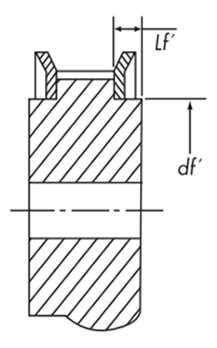
Flange designation
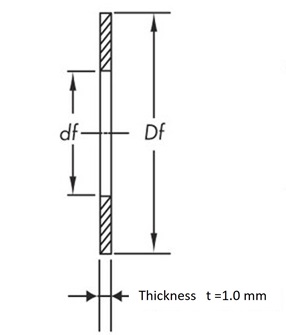
AS Type ...Material: Aluminum
SS Type ...Cold rolled steel
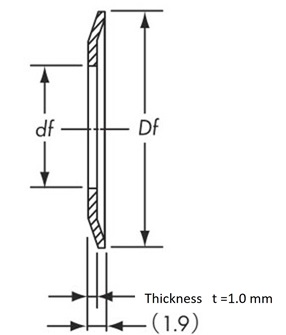
AF Type ...Material: Aluminum
SF Type ...Cold rolled steel
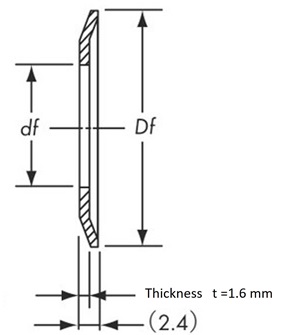
AF Type ...Material: Aluminum
SF Type ...Cold rolled steel
An example of designation

General shape and standard dimensions
| Types (Pitch ) |
Thickness t | Outer Diameter Df Minimum value |
Inner diameter df |
||
|---|---|---|---|---|---|
| Recommended value | Normally used thickness | ||||
| Press type | Turning type | ||||
| P2M | 1.0 | 1.6 | 1.0 ~ 1.6 | Do + 4 | Do - 5 |
| P3M | Do + 4.5 | ||||
| P5M | 2.0 | 1.0 ~ 2.0 | Do + 6.3 | Do - 8 | |
| P8M | 1.6 | 2.5 | 1.6 ~ 2.5 | Do + 8 | Do - 10 |
| P14M | - | 4.0 | 4.0 ~ 5.0 | Do + 14 | Do - 20 |
Depending on standard flanges to use, the OD or ID may be different from those in the above table.
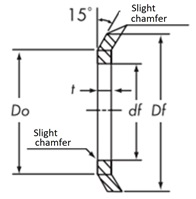
Press type
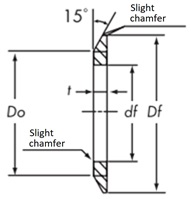
Turning type
Installation of guide flanges
Securing the flange
Clinching
Normally, pressed flanges and turning flanges are secured by caulking using a punch as shown below.
The number of places to clinch is as follows.
| Tip Diameter mm | Up to and incl. 30 | Over 30, up to and incl. 50 | Over 50, up to and incl. 120 | Over 120, up to and incl. 250 |
|---|---|---|---|---|
| Number of places to clinch | 4 | 8 | 12 | 16 |
Notes
- ・Place a belt sprocket on a flat table and clinch the flange using a punch.
- ・When caulking a place opposite the hub, inset the hub to a cylindrical jig placed on the table to ensure it is stable.
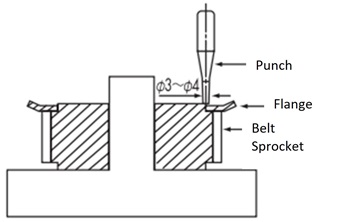
Other fixation methods
Securing with screws
The turning flanges for the belt sprockets with a large number of teeth, such as P8M and P14M, may be attached to the main belt sprocket unit with flathead screws depending on the application.
The number of screws shown in the following table is the minimum number.
| Tip Diameter mm | Up to and incl. 120 | Over 120, up to and incl. 250 | Over 250, up to and incl. 450 | Over 450, up to and incl. 650 |
|---|---|---|---|---|
| Number of screws | 4 | 6 | 8 | 12 |
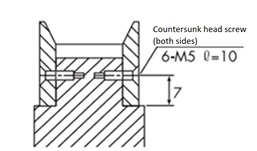
Securing by knurling
Another method often used for caulking is knurling created with a lathe.
Belt Sprocket width

Belt width and Belt Sprocket width
| Types (Pitch ) |
Belt width mm |
Belt Sprocket width (Standard) | ||
|---|---|---|---|---|
| Double-flanged bw |
Flange-less bw' |
Single-flanged bw'' |
||
| P2M | 4 | 5.0 | 9.0 | 7.0 |
| 6 | 7.5 | 11.5 | 9.5 | |
| 10 | 12.0 | 16.0 | 14.0 | |
| P3M | 6 | 7.5 | 11.5 | 9.5 |
| 10 | 12.0 | 16.0 | 14.0 | |
| 15 | 17.0 | 21.0 | 19.0 | |
| P5M | 10 | 11.6 | 16.0 | 13.8 |
| 15 | 16.6 | 21.0 | 18.8 | |
| 25 | 27.6 | 32.0 | 29.8 | |
| P8M | 15 | 16.8 | 22.0 | 19.4 |
| 25 | 27.8 | 33.0 | 30.4 | |
| 40 | 43.8 | 49.0 | 46.4 | |
| 60 | 64.8 | 70.0 | 67.4 | |
| P14M | 40 | 43.0 | 53.0 | 48.0 |
| 60 | 64.0 | 74.0 | 69.0 | |
| 80 | 85.0 | 95.0 | 90.0 | |
| 100 | 106.0 | 116.0 | 111.0 | |
| 120 | 127.0 | 137.0 | 132.0 | |
Backlash-less tooth profile
For synchronous belt engagement, a backlash is usually provided. However, for synchronous belt drive used for robots, electronic component assembling machines, NC machines, printers, plotters, etc. that require highly accurate rotation, belt sprockets having a special backlashless tooth profile with minimal backlash to minimize rotating angle errors are also available. Please contact a Tsubaki representative.

